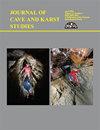新墨西哥地下:跨学科科学与探索的壮观地下系统
IF 0.5
4区 地球科学
Q4 GEOSCIENCES, MULTIDISCIPLINARY
引用次数: 0
摘要
在新墨西哥州,我们欣赏到许多壮丽的风景和各种各样的地质和野生动物。但在我们的脚下,有一个奇妙的隐藏的荒野,很少有人能体验到,除非去卡尔斯巴德洞穴国家公园或埃尔马尔佩斯国家纪念碑的熔岩洞。我们的州有各种各样的地下地形,具有独特的地质环境,起源机制,矿物学,微生物学和野生动物。地下空腔及其伴生岩石裂隙网络作为一个整体系统,是水文系统的重要组成部分,甚至具有自身的微气象行为。尽管在地表之下,洞穴通过物质和能量交换与地表显著耦合,使其成为地球临界带(CZ)的重要组成部分。在一项具有里程碑意义的国家研究委员会研究(2001年)中,它被定义为异质的地表和近地下环境,包括岩石、土壤、水、空气和生物群,这些环境参与复杂的相互作用,调节自然栖息地,从而决定维持包括我们自己在内的生命的资源的获取。地质和地球化学的基本性质与长期以来的地表气候相结合,产生了每个洞穴,并决定了其最终的结构和矿物学性质。目前全球洞穴矿物数量超过300种,其中许多只在洞穴中发现,其中一些只在单个洞穴中发现(White 2016;Hill & Forti, 1997)。这个数字还不包括蝙蝠、鸟类和其他生物有机贡献者在洞穴中产生的许多不寻常的有机矿物质。微生物和一些较大的生物作为地质代理人进一步帮助催化、增强、转化,有时甚至阻碍洞穴系统的地质过程。因此,为了真正了解地下领域,一种涉及所有相关自然科学的综合跨学科方法是必不可少的。许多洞穴系统中包含的古生物学和人类学材料通常将这些发现保存在精美的条件下,这进一步加强了这种理解。本文章由计算机程序翻译,如有差异,请以英文原文为准。
New Mexico Underground: Spectacular Subsurface Systems for Interdisciplinary Science and Exploration
In New Mexico, we enjoy many magnificent landscapes and varieties of geology and wildlife. But beneath our feet, there is a wondrous hidden wilderness that few people experience other than possibly via trips to Carlsbad Caverns National Park or the lava caves at El Malpais National Monument. Our state is graced by a wide variety of subsurface terrains with distinct geological settings, origin mechanisms, mineralogy, microbiology, and wildlife. Functioning as integrated systems, subsurface cavities and associated rock fracture networks are a significant part of hydrological systems, and even possess their own micrometeorological behavior. Although beneath the surface, caves are significantly coupled to the surface by both matter and energy exchanges making them an important part of Earth’s Critical Zone (CZ). This was defined in a landmark National Research Council study (2001) as the heterogenous, surface and near subsurface environment of rock, soil, water, air, and biota that engage in complex interactions that regulate natural habitats, thus determining access to resources that sustain life including our own. The fundamental nature of geology and geochemistry combined with surface climate over time has produced each cave, and governs its resulting structural and mineralogical properties. Cave minerals worldwide currently number more than 300, many of which are found only in caves, and some of which are found only in a single cave (White 2016; Hill & Forti, 1997). And this tally does not include many unusual organic minerals produced in caves with bat, bird, and other biological organic contributors. Microorganisms and some larger organisms act as geological agents further helping to catalyze, enhance, transform, and even sometimes impede the geological processes of cave systems. Thus, in order to truly understand the subterranean realm, an integrated interdisciplinary approach involving all of the relevant natural sciences is essential. This understanding is further enhanced by the paleontological and anthropological materials contained within many cave systems that often preserve these finds in exquisite condition.
求助全文
通过发布文献求助,成功后即可免费获取论文全文。
去求助
来源期刊

Journal of Cave and Karst Studies
地学-地球科学综合
CiteScore
1.90
自引率
0.00%
发文量
6
审稿时长
>12 weeks
期刊介绍:
The Journal of Cave and Karst Studies is a multidisciplinary journal devoted to cave and karst research. The Journal is seeking original, unpublished manuscripts concerning the scientific study of caves or other karst features. Authors do not need to be members of the National Speleological Society, but preference is given to manuscripts of importance to North American speleology.
 求助内容:
求助内容: 应助结果提醒方式:
应助结果提醒方式:


